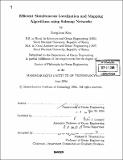| dc.contributor.advisor | John J. Leonard. | en_US |
| dc.contributor.author | Kim, SungJoon, 1970- | en_US |
| dc.contributor.other | Massachusetts Institute of Technology. Dept. of Ocean Engineering. | en_US |
| dc.date.accessioned | 2006-07-13T15:25:15Z | |
| dc.date.available | 2006-07-13T15:25:15Z | |
| dc.date.copyright | 2004 | en_US |
| dc.date.issued | 2004 | en_US |
| dc.identifier.uri | http://hdl.handle.net/1721.1/33448 | |
| dc.description | Thesis (Ph. D.)--Massachusetts Institute of Technology, Dept. of Ocean Engineering, 2004. | en_US |
| dc.description | Includes bibliographical references (leaves 215-223). | en_US |
| dc.description.abstract | Autonomous mapping of large-scale environments has been a critical challenge confronting researchers in mobile robotics. This thesis investigates two aspects of the large-scale simultaneous localization and mapping (SLAM) problem: (1) the behavior of the covariance matrix in the Kalman filter solution to the linear Gaussian SLAM problem, and (2) the development of new algorithms for efficient large-scale mapping. The key issue motivating study of the linear Gaussian SLAM problem is to understand the behavior of the uncertainty estimates with time. In this thesis, we provide an analysis of the asymptotic behavior of the full covariance SLAM solution. We present a novel generalized closed-form solution to the single degree-of-freedom SLAM problem (known as the MonoRob problem). We examine the cross correlation behavior for the case of observed and non-observed features, and show that a feature must be repeatedly reobserved for it to become fully correlated with other features. Additionally, we provide a new "tight" lower bound for the map uncertainty for a certain class of the MonoRob problem. The second part of the thesis develops new techniques for attacking the scaling problem in SLAM. | en_US |
| dc.description.abstract | (cont.) The work builds on the Constant Time SLAM (CTS) method developed by Newman and Leonard, which is the first SLAM algorithm to achieve global convergence while maintaining consistent error bounds with an 0(1) growth of complexity for the linear Gaussian SLAM problem. Our work makes four contributions: (1) We describe a new algorithm, termed CTS 2.0, that achieves better performance than CTS while maintaining constant-time performance. (2) We present an alternative subnmap network SLAM algorithm, termed Network Optimized SLAM (NOS), that transfers information across submaps in O(n) time to achieve faster convergence than CTS while maintaining its desirable consistency properties. (3) we provide a theoretical and experimental analysis of CTS, CTS 2.0, and NOS and compare all three algorithms with the full covariance solution. (4) We perform an analysis of the erro:cr metrics for measuring the global uncertainty of a SLAM solution, yielding new insights into the behavior of this type of algorithm. | en_US |
| dc.description.statementofresponsibility | b y SungJoon Jim. | en_US |
| dc.format.extent | 223 leaves | en_US |
| dc.format.extent | 9228976 bytes | |
| dc.format.extent | 9238436 bytes | |
| dc.format.mimetype | application/pdf | |
| dc.format.mimetype | application/pdf | |
| dc.language.iso | eng | en_US |
| dc.publisher | Massachusetts Institute of Technology | en_US |
| dc.rights | M.I.T. theses are protected by copyright. They may be viewed from this source for any purpose, but reproduction or distribution in any format is prohibited without written permission. See provided URL for inquiries about permission. | en_US |
| dc.rights.uri | http://dspace.mit.edu/handle/1721.1/7582 | |
| dc.subject | Ocean Engineering. | en_US |
| dc.title | Efficient simultaneous localization and mapping algorithms using submap networks | en_US |
| dc.title.alternative | Efficient SLAM algorithms using submap networks | en_US |
| dc.type | Thesis | en_US |
| dc.description.degree | Ph.D. | en_US |
| dc.contributor.department | Massachusetts Institute of Technology. Department of Ocean Engineering | |
| dc.identifier.oclc | 62889446 | en_US |
